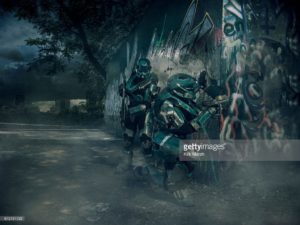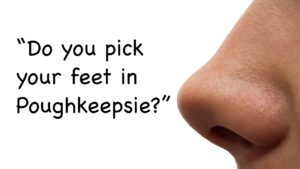(Kirk Marsh, Getty Images. All rights reserved)
(Note from Sweet Joseph: Sorry that we are late this morning, TKZers! In absence of being able to determine why, I’ll chalk it up to a PICNIC (Problem In Chair Not In Computer) problem. Thanks for your patience.)
Greetings, TKZers, and join me today in welcoming Anon du jour who has submitted the first page of his work Bringer of Chaos, Harvest of Blood for examination:
Bringer of Chaos, Harvest of Blood
At the end of Earth’s twenty-seventh century, genslaves, humanity’s genetic
creations, fulfilled man’s every desire. They rebounded from disease and injury as if
immortal. Bred to need no rest, labor-genslaves performed menial and repetitive tasks.
Mankind permitted enough intelligence to work, but not enough to aspire beyond their
station. Warrior genslaves possessed unmeasured strength and massive size. They
fought humanity’s wars, died so man didn’t have to suffer, and revived to fight again.
Healer-genslaves with skill in medicine designed cures for man’s diseases. Artists
created mankind’s beauty. Nurturers and teachers cared for humanity’s children.
Scientist-genslaves designed additional genslaves, to make man’s life even more
pleasant. All with genetic shackles of obedience, making them content to remain
subservient.
While humanity relaxed, secure in a position of power, genslave-scientists created a
new order of beings with free will. Did their creation arise from faulty programming,
or a desire for freedom? Unhampered by genetic restraints, these new creatures
took the name Ultra. Brains and brawn, they solved every problem, survived every
wound.
Untouched by disease and unthwarted by starvation, they beat the shackles of death.
They were immortal.
Immortality changed everything.
When Ultras demanded freedom, humans claimed them soulless, inferior,
unworthy, and undeserving of equality. Humans tried to silence them, and when
that failed, punished them.
The Ultras seized liberty by force. Emboldened by the Ultras’ success,
other genslaves rebelled.
Power tilted. Ultras made slaves of their former captors.
Yet among Ultras, leadership arose that considered humans redeemable. They
advocated human freedom and their own government. They sought an end to
galaxy-wide conflict. They sought peace to halt senseless death and destruction,
foster growth, and increase trade.
In 4536 AD, after centuries of war, Ultras and humans met to discuss a truce.
At the peace talks, the Ultras suffered betrayal at the hand of their own kind.
Captured, forced into cryogenic sleep, transported across the galaxy, abandoned
on a planet whose name meant ever living, a half-million woke in their eternal prison.
Too far out on the rim to be worth developing, Sempervia possessed few
natural resources. The scant supplies humans left would have meant starvation and
lingering death for mortals, but the immortal Ultras had no such mercy.
They survived.
For this reason, the first few years in Sempervian history are remembered as the Harvest of Blood.
Anon, I’m going to focus primarily on substance and a bit on form here, sometimes intermingling the two, so I would appreciate it if you (and those of you who are kind enough to spend a portion of your Saturday with me) would bear with me to the end. I hope that it will be productive for you.
Let’s begin with the title, which reminds me of one of those Swedish death metal records that Jordan Dane probably has in her record collection. It infers that your book would fall into the sword-and-sorcery subgenre, something like Robert E. Howard’s Conan the Barbarian or Fritz Leiber’s Gray Mouser. I expected demons throwing fire, beheadings, supernatural disembowelment, and other things which I won’t get into here. After reading your submission, however, it looks like you are shooting for a speculative history novel and series — a very interesting one — with some military elements thrown in, a book that a publisher such Baen,to name but one, does so well. The title really doesn’t reflect that. It’s somewhat of a misdirection. I would change the title to something a bit simpler which gets your idea across, such as GENSLAVES: Volume One — Rebellion.
The big issue here, however, is that what you have sent isn’t as a practical matter the first page of a Chapter One. It’s not even really the first page of a Prologue. It is more of an outline for a future history spanning hundreds years which will provide the spine for a novel, or maybe even several novels. I think you have a terrific idea, but you don’t have the beginning of a story or a book yet. You have a whole book you can fill, my friend, a whole book where you can show us what you envision as a future history instead of telling us.
One suggestion — out of many possibilities — would be for you to start the first page of your novel on Sempervia, your exile planet. Present it from the perspective of one of the Ultras on the planet who is either 1) hacking their way through a bunch of their fellow Ultras to get to something they need, 2) trying to stow away onto a rocket back to Earth or 3) escaping from a peril. Show us that Sempervia is a bad, lousy place to live, one where unicorns are eaten and recycled instead of worshipped. Show us that while dropping breadcrumbs of the history and the backstory through the narrative. Mix it up a bit, showing how the inhabitants of Sempervia survive on a day to day basis, revealing what their short and long term plans are, and exploring how they got to be there in the first place, all the while sticking to that outline.
Maybe you have already done all of the above in pages two through six hundred of what you have written. That is all well and good; but you need to start the book off in a different manner, in order to pull a prospective agent, editor, or reader into it. Think of your first page — going to back to the spirit which your current title evokes — as the hook which pulls the eyeball of the reader into the story. Folks have short attention spans these days. You need to grab them and keep them before they pick up the television remote and start streaming the first season of Animal Kingdom.
If you want a relatively quick and excellent example of how to do something like this, see if you can get a reading copy of the Gold Key edition of the comic book MAGNUS, ROBOT FIGHTER 4000 AD by Russ Manning ( from the 1963 edition, NOT the relaunches that have been published since) in your local library’s graphic novel section. The first few panels of the story, if memory serves, quickly give the readers example of robots doing drudge work before Magnus suddenly shows up, and, after fleeing from the robot police, uses martial arts to kick rivets and take serial numbers. Manning gradually informs the reader as to how people let robots take over more and more duties (like making coffee, checking people into hotels, and taking orders at Panera Bread) to the point where robots are running things and human beings are becoming subservient without really realizing it. It isn’t your plot, but it does involve a future history, and Manning, bless his heart, shows us all how to tell a future history story effectively. If you want a longer example, check out E. E. “Doc” Smith’s Lensmen series, or Robert H. Heinlein’s future history series. The latter is particularly accessible.
I have a couple of other points of correction, applying to form:
— Science fiction readers love those new names for future objects. You should be consistent when you create and use them. You start off with “labor-genslaves” (hyphen) and then you mention “Warrior genslaves” (no hyphen) instead of “Warrior-genslaves” before returning to “healer-genslaves” and “scientist-genslaves,” the latter of which turn into “genslave-scientists.” Since you started with “(insert type of genslave here) – genslaves,” when naming your characters, follow that format throughout your first page, and indeed, your novels, and the ones that will come later in this ambitious future history.
— If the genslaves were genetically shackled to be obedient, thus making them content to be subservient, they aren’t going to be emboldened by the Ultras’ success. “Emboldened” wouldn’t be in their genetic programming any more than “obedience” is included in a cat’s genetic makeup, even as they watch the dog doing so and thus being allowed to stay another day, go for rides, etc. Just saying.
— The first time that you mention that the high-end genslaves “took the name Ultra,” set the name off, like so: “Ultra” or Ultra. Just the first time.
I will now remain uncharacteristically quiet (for most of the day) while our TKZers offer their own invaluable insight. And thank you, Anon, for stepping up and giving us a reason to be here today!














